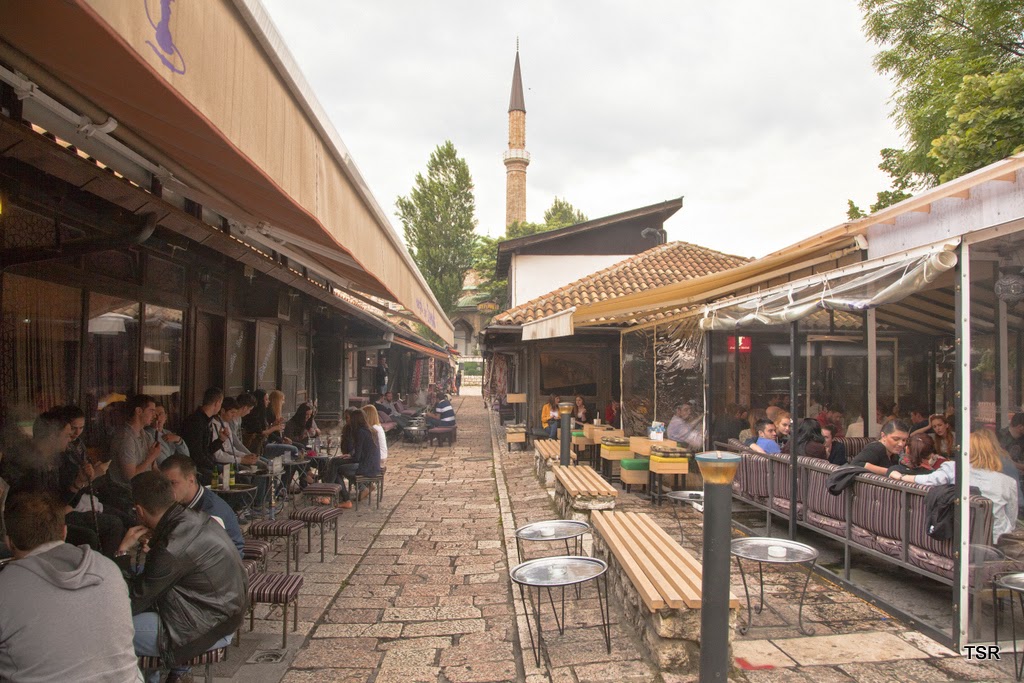Tuesday, June 3
We were up early this morning, as we wanted to see the castle before taking a walking tour at 11:00. The first funicular climbed the Castle Hill at 9:00, so we spent some time visiting the courtyard and exhibits at the town hall, and the market square. In the market, we were interested to see a couple of machines that dispense raw milk and other dairy products, with the farm of origination identified; shoppers can either bring their own containers, or buy sterilized milk bottles via the machine.
We also stopped in the Cathedral of St. Nicholas, adjacent to the market square. The baroque interior was the usual over-the-top baroque, but the three-dimensional bronze doors, which we re-visited with our guide later in the day, were standouts; they depict the story of the city from pre-historic to modern times.
Then, it was the funicular ride up Castle Hill to see the views from the walls, climb even higher to the tower, wander through the former prison cells, and visit the chapel and the museum devoted to Slovenian history.
Back on terra firma, we took the lovely Triple Bridge from the old town to Presernov Square, where the walking tour formed. The square is the main one in Ljubljana and it and the statue that dominates it honor a national hero, France Preseren -- not a general, statesman, or politician, but a poet! He is so revered here that his birthday is a national holiday, Preseren Day. On that day, also known as Slovenian Culture Day, most cultural organizations are open for free and thousands attend hours-long poetry readings in front of the statue -- in February weather!
Our tour was in the very capable hands of Tina, who wove information about the history, politics, architecture, contemporary lifestyle, art, and culture of Ljubljana into a walk that crossed bridges, toured the old town, and the center city -- all completely pedestrianized. Though Slovenia gained independence from Yugoslavia only in 1991, the city's native son, architect Joze Plecnik, foresaw the day when Ljubljana would be the nation's capital and used his vision of what a great city should be to shape much of the newer construction in the historic core. The Triple Bridge, market colonnade, open air theater, and National and University are among his signature contributions to the city. Tina did a great job of helping us sort through some of the ethnic, cultural, and religious jumble that pretty much made the concept of a unified Yugoslavia untenable, especially after the 1980 death of Tito.
We couldn't resist the chance to have burek for lunch one more time. Then, under darkening clouds, we walked along one of the city's streets notable for its Art Nouveau buildings, en route to visit the Metelkova mesto alternative culture center. A thunderstorm broke out just as we approached Metelkova mesto, so we waited it out under cover across the street.
The avant garde center of arts, music, crafts, performance, film, and political activity is housed in a complex of former army barracks. Now, graffiti covers the walls, and every building and courtyard bears the marks of the free expression of free spirits -- this may be the origin of the term "outside the box!"
 We had traditional Slovenian food for dinner tonight, at a small restaurant in the old town, then walked around a bit, along the river, sidewalk (and center-of-the-street) restaurants and cafes, and through the squares. There was music and conversation in the air, but no cars, horns or exhaust fumes!
We had traditional Slovenian food for dinner tonight, at a small restaurant in the old town, then walked around a bit, along the river, sidewalk (and center-of-the-street) restaurants and cafes, and through the squares. There was music and conversation in the air, but no cars, horns or exhaust fumes!  We learned today that when Ljubljana's central core was pedestrianized seven years ago, most residents were pleased and felt that their quality of life was enhanced. Some, however, were inconvenienced and the disabled, elderly, and others had difficulty getting around. In a step we haven't seen in any other place, the city government here provides a fleet of electric carts that anyone can hail to be driven anywhere in the pedestrian zone -- for free! Also, bicycles are allowed in the pedestrian areas; we've seen more bikes here than anywhere else on our trip.
We learned today that when Ljubljana's central core was pedestrianized seven years ago, most residents were pleased and felt that their quality of life was enhanced. Some, however, were inconvenienced and the disabled, elderly, and others had difficulty getting around. In a step we haven't seen in any other place, the city government here provides a fleet of electric carts that anyone can hail to be driven anywhere in the pedestrian zone -- for free! Also, bicycles are allowed in the pedestrian areas; we've seen more bikes here than anywhere else on our trip.
We added Slovenia to our itinerary fairly late in our planning, and are so glad that we did. The countryside of this small country is lovely; Ljubljana is a fine and cultured capital city, with forests at its doorstep and views of the Alps. Wow!
Tomorrow, we begin our trip home with a day-long drive to Nice, France. We'll return our car there, spend the night at an airport hotel, and catch a flight to London Thursday morning, and home from there later in the day. All good things must come to an end, so that even better ones can begin!











































